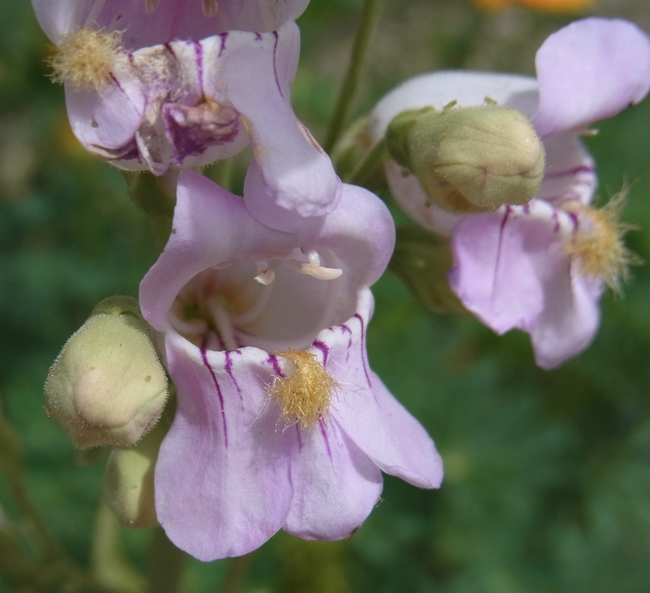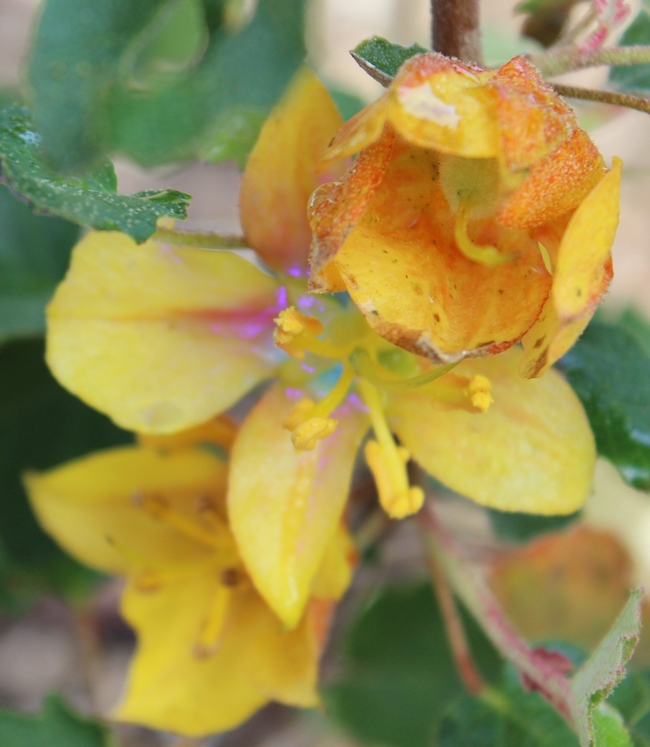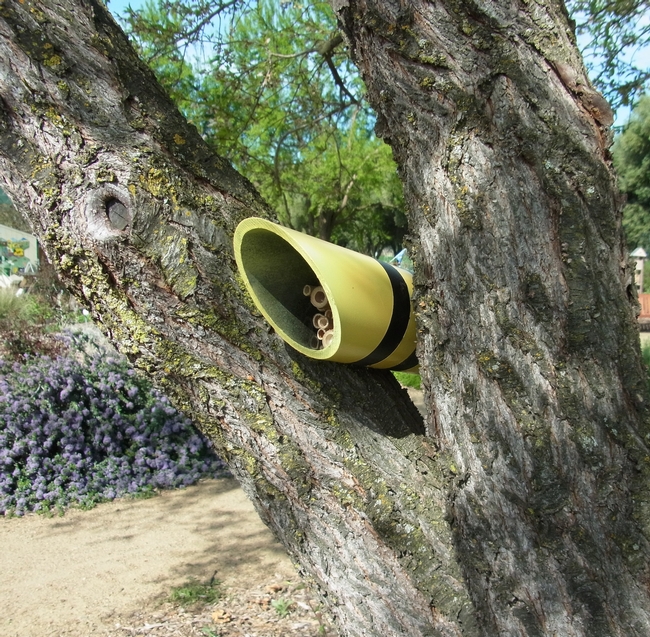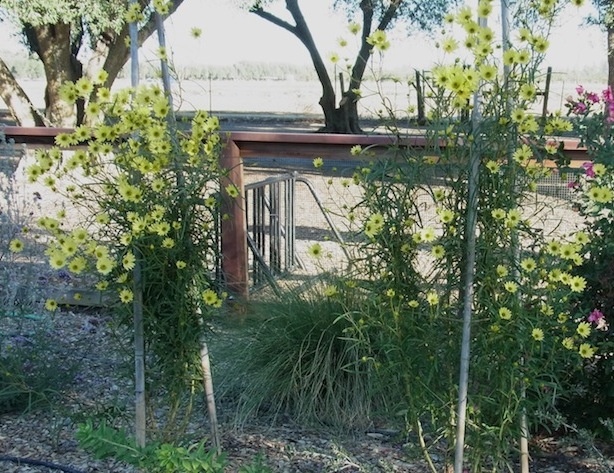- Author: Kirsten Pearsons
Everyone can appreciate the beauty of flowers, but that's not to say flowers look nice just for us! We often get asked by Haven visitors how bees find their flower hosts. One way is through unique flower colors and shapes. Once bees are near a plant, flowers with intricate patterns can entice them even further through patterns on the petals that direct bees straight towards nectar rewards. Like runway lights at the airport, these intricate nectar guides can help orient pollinators during their flower visits.
Nectar guides are doubly useful for bees, as they use guides at individual flowers to find nectar faster and as search images to target similar flowers. Since plants of the same species tend to be flowering at the same time, loyal bees can be more efficient than bees that hop from one species to another. It's a win-win situation since loyal bees can collect nectar with less effort and the flowers get a greater chance of receiving pollen from their own species (Functional Ecology 2011, 24, 1293-1301).
So what about simple monotone flowers? Well, the thing about nectar guides is that we humans can't always see what the bees do! We can see all of the colors from red to violet, but bees see a shifted spectrum from yellow through ultra-violet (UV). So to bees, even seemingly plain flowers may have bold nectar guide patterns. With UV sensors, even humans can get a glimpse of what nectar guides look like to bees. (Plant Species Biology 2013, 28, 177-184). The web site Flowers in Ultra-Violet has many images comparing flowers in daylight and UV light in which the guides are visible.
Other than bees, hummingbirds, hawkmoths, and syrphid flies have been found to respond to nectar guides. Some flowers even have overlapping visible nectar guides and UV nectar guides, possibly to attract birds and bees simultaneously. (Functional Ecology 2011, 24, 1293-1301).
As you walk through the Haven, look at our flowers for these intricate patterns. Here are two of the species in our garden with visible nectar guides:



- Author: Christine Casey
The Häagen-Dazs Honey Bee Haven will hold our last open house of the year on October 3, 2014. Please join us for special events and activities from 5:30pm to 7pm. Specimens of the garden's most common bees will be available for viewing and tips on identifying bees will be presented. A guided tour at 6pm will focus on fall- and winter-blooming bee plants and several styles of bee houses will be available for purchase to support the garden.
The Häagen-Dazs Honey Bee Haven is a half-acre garden located on the UC Davis campus devoted exclusively to bee pollinator conservation and education. We offer free admission and are open every day from dawn to dusk. From Hutchison Drive, take Hopkins and make the first right onto Bee Biology Road; the garden is at the end of the road.


- Author: Christine Casey
Nothing says late summer like sunflowers. No matter where they are growing -- a commercial crop, flowers in a garden, or volunteers by the side of the road -- this iconic yellow flower reminds us that fall is around the corner.
Sunflowers are visited by a variety of bees; these visits are so consistent that sunflowers are used as the sentinel plant in The Great Sunflower Project, a San Francisco State University-based citizen science project to monitor bees.
Among the bees that visit sunflowers are honey bees and a complex of California native bees known collectively as sunflower bees. Surveys in Yolo and Solano counties found that 25 species of native bees visited sunflower crops, with an average of 37% of visits from native bees (Fremontia (2002) 30 (3-4): 41-49). Other research in Yolo County showed an interesting behavioral interaction between introduced honey bees and the native bees that, on average, doubled the pollination service of the honey bees that are typically placed in sunflower crops (PNAS (2006) 103:13890-13895).
These native bees include Diadasia spp., Melissodes spp., and a perennial visitor to my own bee garden, Svastra obliqua. Visit the Haven's YouTube channel to see video of this bee leaving its overnight sleeping aggregation as it warms up in the morning.
Sunflowers and other fall-blooming plants provide critical resources for honey bees as they put up stores of honey for the winter. Join us at the Haven for our fall open house, October 3 from 5:30 to 7pm, to see these and other fall-blooming bee plants.



- Author: Christine Casey
How is the California drought affecting bees? Many Haven visitors have asked that question. Drought affects bees in several ways; the good news is that we can provide some relief in our bee gardens. Some considerations:
Water
Honey bees need water to cool the hive and to dilute the honey they feed to developing bees. This is why it's essential to include a water source in your bee garden. See this previous Bee Gardener post for more information.
Parasites
The honey bee-parasitic varroa mite, Varroa destructor, has had a devastating effect on honey bee health. The good news is that multi-year droughts can reduce the mite's reproductive rate (Environ. Entomol. (2003) 32(6): 1305-1312).
Floral resources
Drought-stressed plants produce fewer, shorter-lasting flowers. Lack of adequate, high-quality forage has been identified in a USDA study as a major factor in bee health decline.
Less obvious than the absence of flowers is the quality of the food they provide. In a study of squash plants subjected to simulated drought, it was determined that the daily pattern of nectar secretion was unaffected by drought. The volume and concentration of nectar declined with the length of the simulated drought, however, indicating a negative effect of drought on the floral resource that bees depend on (Apidologie (2012) 43:1–16).
Many of our native bees are feeding specialists that will only use one species or genus of plant. What happens if that plant suffers during drought? Many animals native to areas with regular dry periods have evolved diapause as a survival mechanism. A study of in bees in the southwestern US desert found that they were able to reliably use environmental cues to enter diapause when their plant resources were affected by drought (Proc. R. Soc. B (2013) 280: 20122703).
Effective use of limited water in the bee garden
Many communities are under mandatory water restrictions, and groundwater levels are at record lows throughout California. How do we balance this with the needs of these vital insect pollinators?
- Save the rest of this year's water for the plants that have yet to bloom. Fall and winter are critical times for honey bee foraging to ensure ample honey stores for the winter. In the Haven we are reducing irrigation to the plants that are finished blooming for the year so we can focus water use on the sunflowers, asters, sedums, and other plants that will bloom until frost.
 Chaparral currant, Ribes malvaceum is a native plant that is stress-deciduous. We'll let these go dormant to save water for the plants that are still to bloom.
Chaparral currant, Ribes malvaceum is a native plant that is stress-deciduous. We'll let these go dormant to save water for the plants that are still to bloom.
- Provide an efficient water source. The Haven's self-watering container made from a soaker hose runs on a timer. This provides water for our bees while re-using the water for irrigating the plant in the container.
 Bee watering container made from a soaker hose
Bee watering container made from a soaker hose
- Plant drought-tolerant bee plants for next year. We have suggestions on the garden's web site.



- Author: Christine Casey
As we move into the heat of the summer, few plants show their value as bee plants for hot, dry gardens better than the salvias. Known by both their common name, sage, and their genus name, salvia, we have a tremendous number of these plants in the Haven for good reason. No bee garden should be without a salvia!
For gardeners interested in learning more about this group, two books are recommended. Long-time salvia fans will be familiar with The New Book of Savias: Sages for Every Garden (2003) by Betsy Clebsch. Newly published is The Plant Lover's Guide to Salvias by Northern California nurseryman John Whittlesdy. This book updates gardeners on many of the new species and cultivars in the trade and has great color photographs, including some with bees.
Salvias in the Haven
Here is a sampling of the salvias planted in the Haven. A complete garden plant list is here. Salvias do best in full sun, but can take partial shade (although flowering will be reduced). They need well-drained soil and little water, except as noted below. Most do best when cut back hard in the fall (except for the winter-bloomers, which should be pruned after flowering).
Cleveland sage, Salvia clevelandii. This uniquely-scented plant is a favorite of both bee and human visitors to the garden. A California native, it has soft grey-green leaves and purple flowers that bloom from May until late summer. There are a number of cultivars and hybrids with other native sages, many of which are only available through specialty nurseries and plant sales. Two that are most commonly used in gardens are the cultivars ‘Allen Chickering' and ‘Winifred Gilman'. Both are becoming more common in garden centers as customers look for drought-tolerant plant options. ‘Allen Chickering' grows to about five feet tall and wide, while ‘Winifred Gilman' tops out at about three by three. ‘Winifred Gilman' also has the deepest purple flowers of the group.


Brandegee's sage, Salvia brandegii. One of my personal favorites, this California native blooms from January through May and intermittently the rest of the summer. It provides vital early-season forage and is a bee favorite. Textured leaves add to its interest. It reaches about three feet tall with a spread of at least twice that. The cultivar ‘Pacific Blue' has lavender flowers while the species has white flowers.

Hummingbird sage, Salvia spathacea. Pineapple-scented leaves and bright pink flowers make this California native salvia a standout in the garden. More tolerant than shade of most sages, this is a good choice for planting underneath native oaks that cannot have summer water. Unlike other sages, it spreads by underground rhizomes and will colonize a large area.
Autumn sage hybrids, Salvia greggii; Salvia greggii x microphylla; Salvia hybrida. I couldn't begin to do justice to the diverse members of this group in one blog post. A few of the best performers at the Haven are ‘Hot Lips' (red and white flowers); ‘Lipstick' (red flowers); ‘San Carlos Festival' (bright pink flowers); and the Heatwave series (several flower colors).

Bog sage, Salvia uliginosa. Unlike most sages, this one needs regular moisture and part shade. At the Haven we grow it near one of our bee waterers to provide this; I've also grown it as a container plant. Tall flower spikes with light blue flowers distinguish this bee favorite, which can spread vigorously with the right conditions.





